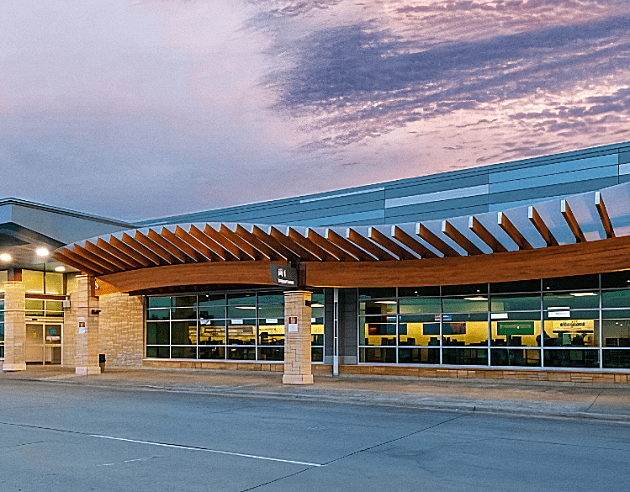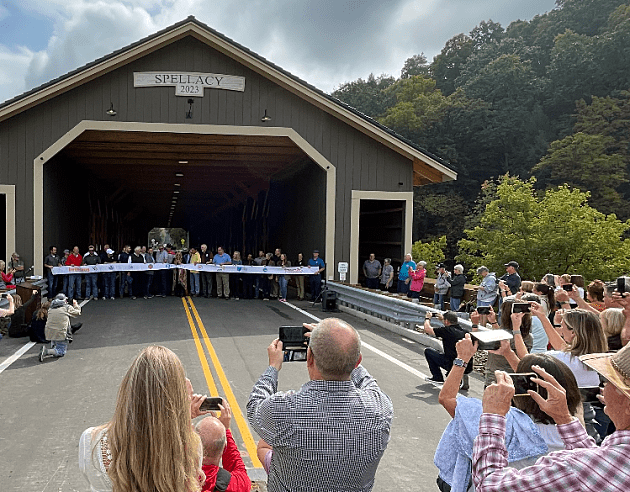- Project uploaded by Canadian Wood Council on 03-24-2023
- Project last updated by WoodWorks on 06-10-2024
Duchesney Creek Bridge
North Bay, ONOriginally built in 1937, the Duchesnay Creek Bridge connects Highway 17B across Duchesnay Creek in Commanda Township, ON. Highway 17B remains an arterial road in North Bay, ON, moving traffic from the Trans-Canada Highway 17 to the city and being the main access road within the Nipissing First Nation community.
The original structure (74 m. long and 11 m. wide) was the only one of its kind in Ontario, comprising a timber deck truss main span flanked by several shorter approach spans of timber beams supported by timber pile bents. A preliminary design study completed in 2015 determined the bridge needed to be replaced.
Given the heritage value of the original timber truss bridge, the picturesque site adjacent to Lake Nipissing, and the roots the bridge had within the First Nation community, consideration was given to integrate timber in the new bridge structure. Several studies and assessments later, it was decided that a new timber bridge would replace the original structure, preserving continuityin the historical record and its heritage value.
The proposed design was a three span glulam girder bridge with a precast concrete deck and arched glulam braces at the piers. The total length of the bridge is 83 m. with the longest span being 39 m. The braces allow for shallower girder depth while adding to the distinctive aesthetics of the new structure, with the bridge railings and new girders enhancing the cultural landscape at the site.
The bridge was constructed using glulam sections of Douglas fir timber from Canada’s West Coast. Fabrication was completed in Montréal, where the fabricator had to pay precise attention to detail; the slightest mistake in lamination, cutting, or drilling of holes could have resulted in major issues during erection. The beams and arches were pressure-treated with pentachlorophenol at the only facility in Canada with a large enough vessel to properly treat them.
This project was the first to be built on a provincial highway in Ontario using glulam girders and a precast concrete deck. Glulam was selected for its high strength-to-weight ratio— stronger than steel pound for pound. Thanks to technological innovations, glulam also allows for larger spans and heavier loads in comparison to traditional dimension lumber bridges.
Today, there are an estimated 70,000 bridges across Canada with less than 2% fabricated from timber. Although timber bridges have been limited by their ability to span longer distances and carry heavy truck traffic in the past, technological innovations have allowed for larger spans to be achieved and larger loads to be supported. Given the right conditions and utilizing new advances in timber technology, it is feasible for timber bridges to span more than 75 m.
The iconic Duchesnay Creek Bridge will help promote and encourage the use of timber resource-based manufacturing, utilizing renewable resources that can help reduce the effects of climate change. As the technology and industry evolve throughout Ontario, there may also be a cost decrease for future timber structures.
Project Details
-
Year Built
2021
-
Number Of Stories
2
-
Bldg system
Mass Timber
-
Square footage
20,000
-
Construction Type:
Unknown
-
Building Type:
Transportation (Airports, Train or Subway Stations)
-
Material Types:
Glue-Laminated Timber (GLT or glulam)
Lumber
Project Team
-
DTAH ARCHITECTS
-
LEA Consulting Ltd. ENGINEERS
- Project uploaded by Canadian Wood Council on 03-24-2023
- Project last updated by WoodWorks on 06-10-2024



 WOODWORKS
INNOVATION
NETWORK
WOODWORKS
INNOVATION
NETWORK




